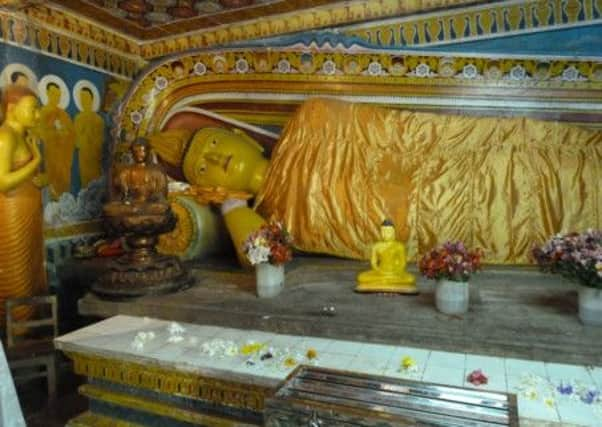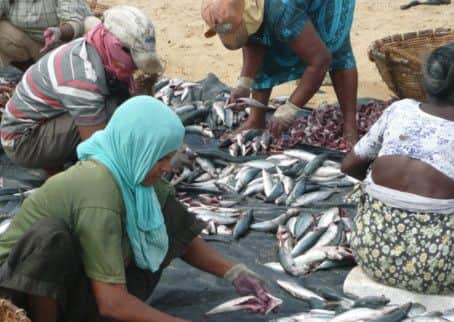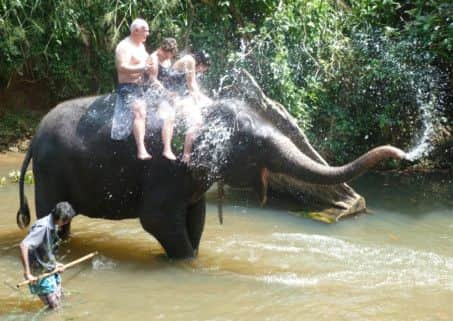Travel: Elephants, fish, dolphins… and weddings!


Having spent four tiring but exciting days travelling around Sri Lanka’s hill country visiting elephant orphanages, temples and tea plantations, it was time to return to the west coast and our chosen resort hotel in Waikkal, the Hotel Club Dolphin.
Having already spent one night there before our 750 kilometre tour began, we were welcomed back by the staff like old friends for a ten day stay on an all-inclusive board basis.
Advertisement
Hide AdAdvertisement
Hide AdHowever there’s only so much lying by the hotel’s massive swimming pool (it’s said to be the largest in Asia at around 150 metres long) and enjoying the Indian Ocean surf that I could take, so it wasn’t long before we began arranging further trips with the locals.


Right behind the Club Dolphin you can’t fail to notice the Dutch Canal. It’s a tremendous feat of engineering and was created by the Dutch settlers who managed to dig out a series of waterways – many being open to the sea – to link Colombo in the south to the town of Puttalam in the north, a distance of around 90 kilometres.
Boarding Harald Travel’s small Yamaha-powered boat, we made off into the canal system on a fabulous bird watching trip. Besides four brightly coloured species of kingfishers, various herons, egrets and bitterns – plus all manner of kites and eagles – the stunning little green bee-eaters were everywhere as we threaded our way between the mangrove covered banks which are home to numerous two metre long monitor lizards.
Young children were often seen swimming and playing in the canal while many of the coconut palms had been purposely ‘slashed’ to make the island’s favourite spirit drink, Arrack.
Advertisement
Hide AdAdvertisement
Hide AdI even tried fishing in the canal for a couple of hours but without success, those huge red snappers and barramundi that I’d been told about were clearly not interested in my bait!


On another day, a 90 minute drive south from our hotel brought us to the island’s busy commercial centre, Colombo.
There is a newly-constructed toll motorway linking the city with the international airport which has been built by the Chinese who, for an agreed 15 years, can claim all of the toll money before it is handed back to the Sri Lankans. Another motorway section has been constructed south of Colombo but it has not yet been linked up with the northern one.
Many people mistakenly believe that Colombo is Sri Lanka’s capital city but that honour goes to Sri Jayawardenapura Kotte which is just eight kilometres further south, the decision being made in recent years to make the switch due to the traffic congestion and overcrowding.
Advertisement
Hide AdAdvertisement
Hide AdBest described as an urban sprawl, Colombo is easily the country’s biggest city and it stretches out for around 40 miles while hugging the island’s western coastline.
Home to over three million Sri Lankans, Colombo is a mix of ancient and modern… it’s really crowded, noisy and chaotic with traffic – which drives on the left although you would never guess it! – it’s a real nightmare, yet it somehow seems to work.
Shanty-like areas are common while many foreign embassies are located in the richer suburbs. We elected to spend a few hours visiting the city’s zoo which is already in the throws of being relocated. A new one is being developed within the city limits while a more spacious state-of-the-art zoo is already under construction close to the Pinnawala Elephant Orphanage near to Kandy.
Sadly the zoo was pretty much as we expected; dirty, smelly and with cages and enclosures far too small for the majority of the animals, many of which looked in poor condition.
Advertisement
Hide AdAdvertisement
Hide AdHowever the area around the newly-constructed island-style parliament building and the high-rise tower blocks in the commercial sector are very impressive. They are also overshadowed by the twin towers of Sri Lanka’s World Trade Centre, built to a similar style to that in New York which were destroyed by the al-Qaeda attack on September 11, 2001.
After a short(ish) shopping trip to Odel – I likened it to a smaller John Lewis-style store – we made for the Gangaramaya Temple which was busy preparing for the annual Nawam Perahera.
A hugely popular and colourful Buddhist pagent, Nawam Perahera takes place this year on Friday and Saturday, February 14 and 15 and will be led by the temple’s own elephants. Golden caskets holding holy relics associated with the Buddha will be mounted on the elephant’s backs while colourful costumed dancers and drummers will fill the streets.
Our guide on this occasion was 42-year-old Vijay ‘Richie’ Kumara, one of the Club Dolphin’s animation team members who volunteered to spend the day with us. However he admitted that he had never actually visited the temple before and was bowled over by its grandeur.
Advertisement
Hide AdAdvertisement
Hide AdAll foreign visitors to the Gangaramaya Temple are asked to give a 200 rupee donation (about £1) which is passed on to the nearby Sri Jinaratana Bhikku Abhyasa Vidyalaya Children’s Home.
Having looked around the adjoining temple museum, we then watched two Buddhist monks lovingly scrubbing one of the younger elephants in a special bathtub before returning to our hotel via the old colonial Galle Face Hotel and the ramshackle district known as Slave Island, named after the African slaves who were once held their by the Portuguese and Dutch.
On another day we took a Tuk-Tuk ride from the Hotel Dolphin to Negombo’s amazing fish market. It cost just 1500 rupees (approximately £7.50) for the three of us on a round trip, our driver happy to act as a broken English informative guide.
There are simply hundreds of small, colourful trawlers in Negombo’s harbour while we also watched fisherman paddling Oruwas – wooden canoe-type craft with flimsy catamaran-like outriggers – back to shore with their early morning catches.
Advertisement
Hide AdAdvertisement
Hide AdHundreds of locals buy their fish direct from these Karava fisherman who were happy to sell from their rickety boats before attending to their nets while close by were dozens of women squatting on the beach, knives in hand gutting heaps of the sea’s silver haul.
Besides a huge variety of fish – including tuna, shark, pilchards and king fish – there were fresh crabs, lobsters and differing sizes of shrimp and prawns for sale.
Close by was St Mary’s Church, a huge pinkish Catholic building, testament to the island’s Christian population. And as usual during the month of January, there was a wedding in full swing. We were quickly invited in to join the other guests for a slice of wedding cake and a drink – just as long as we could be photographed with the bride and groom!
On the way back we popped into another small spice garden before we drove alongside the Dutch Canal which links Colombo to the town of Puttalam which is close to where we paid a visit to the huge pods of bottlenose dolphins that swim in what is basically the Bay of Bengal off the small village of Kalpitiya.
Advertisement
Hide AdAdvertisement
Hide AdDonning life-vests, we climbed aboard a small outboard-engined fibreglass boat and travelled out some eight kilometres where we came across simply hundreds of dolphins.
The previous day when the sea had been calmer, our ‘captain’ estimated that around 2,000 dolphins had formed a huge ‘super pod’, but as the waves were much bigger and the sea extremely choppy, we were down to hundreds. However the sight of dolphins spinning and leaping around our boat was still simply amazing!
At certain times of the year, both Blue and Sperm whales can be spotted off the west coast although further south near the town of Galle you are almost guaranteed to see the world’s largest mammals.
We were certainly well looked after at out chosen hotel, for having booked spacious superior sea view rooms, the attention to detail was certainly impressive and the staff couldn’t do enough for us.
Advertisement
Hide AdAdvertisement
Hide AdWith 104 bedrooms and a 50 lovely garden chalets, the 40-acre, 30-year-old Club Dolphin beachfront site is spotless thanks to a total of 310 staff who all sang the praises of the hotel’s Germany manager Daniel Ludwig. Hannover-born Daniel obviously goes out of his way to keep them happy and even invites their whole families to dine at the hotel at his own expense when it’s their birthday.
And talking of dining, the choice of cuisine was always amazing… especially if you like curries! They were available morning noon and night as Sri Lankans eat them for breakfast as well. And besides the usual international main coarse dishes, the choice of fruits and desserts were amazing.
There’s the usual fun-loving animation team who try their hardest to entertain in the hotel’s large open-air theatre while there are plenty of activities to keep the guests entertained including: keep fit, archery, snooker, squash, badminton, tennis, pool, water polo together with Sri Lanka’s national spot, volleyball.
Cricket is also played everywhere and there was plenty of interest in the current Test Match series between Sri Lanka and Bangladesh with many of the hotel’s public area television screens tuned in to enable the waiters and staff to take a sneaky peek.
Advertisement
Hide AdAdvertisement
Hide AdI asked the Dolphin’s guest co-ordinator Thyagi why there were so many weddings taking place – we often had four or more every day at the hotel – and learned that January is traditionally the month for Buddhists to marry.
However it also seemed to be the month for Christian weddings as there were just as many brides immaculately dressed in white as there were in the stunning traditional red and gold of the Buddhists ceremonies.
Overall it was a stunning holiday and one which will long remain in my memory.
Sri Lankan Fact File
Alan Wooding’s Sri Lanka trip was booked through Travelbag Ltd (London), 205 Kensington High Street, London W8 6BA, telephone 0844 846 5651 – www.travelbag.co.uk – with special thanks to travel consultants Sarah Lockwood and Rianne Ojeh.
Advertisement
Hide AdAdvertisement
Hide AdTravel: Flying non-stop overnight with Sri Lankan Airlines from Terminal 4 of London’s Heathrow Airport direct into Colombo’s Bandaranaike International Airport takes around 10 hours although some airlines call in at Dubai for a short stopover.
Hotel: Many thanks to Daniel Ludwig and the entire staff of Serendib Leisure’s Club Hotel Dolphin, Kammala South, Waikkal, Sri Lanka, telephone 0094 31 487 7100 – www.serendibleisure.com/club-hotel-dolphin reservations call 0094 11 479 0500, [email protected] –
Geography: Sri Lanka is a small island of 66,000 square kilometres with a population of around 22 million. It lies in the Indian Ocean some 880kms north of the equator. Coastal beaches merge into jungle and hill country with peaks reaching heights of over 2,400 metres. You can expect to see terraced tea and vegetable plantations, waterfalls and lakes along with unspoiled palm lined sandy beaches with coral reefs, rice paddies, wildlife parks filled with animals in their native habitat... and much more.
Climate: Being a tropical country, Sri Lanka’s low lying coastal regions have a year-round temperature of around 30 degrees while in Kandy it’s nearer 25 and in Nuwara Eliya 20. The hottest time is March to June and the coolest November to January. The southwest monsoon (May to July) affects the southern, western and central regions while the northwest monsoon (December to January) affects the eastern and northern areas.
Advertisement
Hide AdAdvertisement
Hide AdMajor exports: Tea, rubber, gemstones, coconuts and textiles.
Religion: Buddhists 69%, Hindus 15%, Christians 8%, Islam 8%.
Sri Lankan currency: The Sri Lankan rupee comes in banknote denominations of 10, 20, 50, 200, 200, 500, 1000, 2000 and 5000 while there are coins of 1,2, 5 and 10 rupees together with smaller cents of 5, 10, 25 and 50 although these are rarely seen by tourists. Although exchange rates change daily, there are approximately 210 rupees to the British pound while for Euros its around 175 and the US dollar 130.